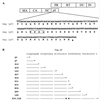Functional roles of equine infectious anemia virus Gag p9 in viral budding and infection
- PMID: 11559809
- PMCID: PMC114548
- DOI: 10.1128/JVI.75.20.9762-9770.2001
Functional roles of equine infectious anemia virus Gag p9 in viral budding and infection
Abstract
Previous studies utilizing Gag polyprotein budding assays with transfected cells reveal that the equine infectious anemia virus (EIAV) Gag p9 protein provides a late assembly function mediated by a critical Y(23)P(24)D(25)L(26) motif (L-domain) to release viral particles from the plasma membrane. To elucidate further the role of EIAV p9 in virus assembly and replication, we have examined the replication properties of a defined series of p9 truncation and site-directed mutations in the context of a reference infectious molecular proviral clone, EIAV(uk). Characterization of these p9 proviral mutants revealed new functional properties of p9 in EIAV replication, not previously elucidated by Gag polyprotein budding assays. The results of these studies demonstrated that only the N-terminal 31 amino acids of a total of 51 residues in the complete p9 protein were required to maintain replication competence in transfected equine cells; proviral mutants with p9 C-terminal truncations of 20 or fewer amino acids remained replication competent, while mutants with truncations of 21 or more residues were completely replication defective. The inability of the defective p9 proviral mutations to produce infectious virus could not be attributed to defects in Gag polyprotein expression or processing, in virion RT activity, or in virus budding. While proviral replication competence appeared to be associated with the presence of a K(30)K(31) motif and potential ubiquitination of the EIAV p9 protein, mutations of these lysine residues to methionines produced variant proviruses that replicated as well as the parental EIAV(uk) in transfected ED cells. Thus, these observations reveal for the first time that EIAV p9 is not absolutely required for virus budding in the context of proviral gene expression, suggesting that other EIAV proteins can at least in part mediate late budding functions previously associated with the p9 protein. In addition, the data define a function for EIAV p9 in the infectivity of virus particles, indicating a previously unrecognized role for this Gag protein in EIAV replication.
Figures






Similar articles
-
Functional replacement and positional dependence of homologous and heterologous L domains in equine infectious anemia virus replication.J Virol. 2002 Feb;76(4):1569-77. doi: 10.1128/jvi.76.4.1569-1577.2002. J Virol. 2002. PMID: 11799151 Free PMC article.
-
Equine infectious anemia virus utilizes a YXXL motif within the late assembly domain of the Gag p9 protein.J Virol. 1997 Sep;71(9):6541-6. doi: 10.1128/JVI.71.9.6541-6546.1997. J Virol. 1997. PMID: 9261374 Free PMC article.
-
Equine infectious anemia virus Gag p9 function in early steps of virus infection and provirus production.J Virol. 2005 Jul;79(14):8793-801. doi: 10.1128/JVI.79.14.8793-8801.2005. J Virol. 2005. PMID: 15994773 Free PMC article.
-
Regulation of equine infectious anemia virus expression.J Biomed Sci. 1998;5(1):11-23. doi: 10.1007/BF02253351. J Biomed Sci. 1998. PMID: 9570509 Review.
-
Virulence determinants of equine infectious anemia virus.Curr HIV Res. 2010 Jan;8(1):66-72. doi: 10.2174/157016210790416352. Curr HIV Res. 2010. PMID: 20210781 Review.
Cited by
-
Regulation of APOBEC3 proteins by a novel YXXL motif in human immunodeficiency virus type 1 Vif and simian immunodeficiency virus SIVagm Vif.J Virol. 2009 Mar;83(5):2374-81. doi: 10.1128/JVI.01898-08. Epub 2008 Dec 24. J Virol. 2009. PMID: 19109396 Free PMC article.
-
Receptor-mediated entry by equine infectious anemia virus utilizes a pH-dependent endocytic pathway.J Virol. 2005 Dec;79(23):14489-97. doi: 10.1128/JVI.79.23.14489-14497.2005. J Virol. 2005. PMID: 16282448 Free PMC article.
-
Cysteine 95 and other residues influence the regulatory effects of Histidine 69 mutations on Human Immunodeficiency Virus Type 1 protease autoprocessing.Retrovirology. 2010 Mar 23;7:24. doi: 10.1186/1742-4690-7-24. Retrovirology. 2010. PMID: 20331855 Free PMC article.
-
Autoprocessing of human immunodeficiency virus type 1 protease miniprecursor fusions in mammalian cells.AIDS Res Ther. 2010 Jul 28;7:27. doi: 10.1186/1742-6405-7-27. AIDS Res Ther. 2010. PMID: 20667109 Free PMC article.
-
Heterologous late-domain sequences have various abilities to promote budding of human immunodeficiency virus type 1.J Virol. 2005 Jul;79(14):9038-45. doi: 10.1128/jvi.79.14.9038-9045.2005. J Virol. 2005. PMID: 15994797 Free PMC article.
References
-
- Bachand F, Yao X J, Hrimech M, Rougeau N, Cohen E A. Incorporation of Vpr into human immunodeficiency virus type 1 requires a direct interaction with the p6 domain of the p55 gag precursor. J Biol Chem. 1999;274:9083–9091. - PubMed
-
- Beaufils P, Choquet D, Mamoun R Z, Malissen B. The (YXXL/I)2 signalling motif found in the cytoplasmic segments of the bovine leukaemia virus envelope protein and Epstein-Barr virus latent membrane protein 2A can elicit early and late lymphocyte activation events. EMBO J. 1993;12:5105–5112. - PMC - PubMed
Publication types
MeSH terms
Substances
Grants and funding
LinkOut - more resources
Full Text Sources
Other Literature Sources

